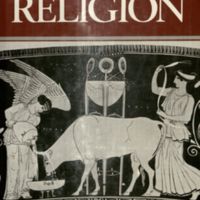Greek Religion
Dublin Core
Title
Greek Religion
Subject
Gods, Greek
Greece -- Religion
Greece -- Religion
Description
This is the first major synthesis of Greek religion to appear for a generation. A clearly structured and readable survey for classical scholars and students, it will also be generally welcomed as the best modern account of any polytheistic religious system. The text builds up an impressive and coherent picture of the current state of knowledge about the religion of the ancient Greeks.
Creator
Walter Burkert
Date
1985
Contributor
Translated by John Raffan
Table Of Contents
Cover; Title Page; Contents; Preface to the English Edition; Introduction; 1 A Survey of Scholarship; 2 The Sources; 3 The Scope of the Study; I Prehistory and the Minoan-Mycenaean Age; 1 The Neolithic and Early Bronze Age; 2 Indo-European; 3 The Minoan-Mycenaean Religion; 3.1 A Historical Survey; 3.2 The State of the Sources; 3.3 The Cult Places; Caves; Peak Sanctuaries; Tree Sanctuaries; House Sanctuaries; Temples; Graves; 3.4 Rituals and Symbols; 3.5 The Minoan Deities; 3.6 The Mycenaean Gods and Linear B; 4 The 'Dark Age' and the Problem of Continuity; II Ritual and Sanctuary
1 'Working Sacred Things': Animal Sacrifice1.1 Description and Interpretation; 1.2 Blood Rituals; 1.3 Fire Ritualso; 1.4 Animal and God; 2 Gift Offerings and Libation; 2.1 First Fruit Offerings; 2.2 Votive Offerings; 2.3 Libation; 3 Prayer; 4 Purification; 4.1 Function and Methods; 4.2 The Sacred and the Pure; 4.3 Death; 4.4 Purification by Bloodo; 4.5 Pharmakos; 5 The Sanctuary; 5.1 Temenos; 5.2 Altar; 5.3 Temple and Cult Image; 5.4 Anathemata; 6 Priests; 7 The Festival; 7.1 Pompe; 7.2 Agermos; 7.3 Dancing and Hymns; 7.4 Masks, Phalloi, Aischrologia; 7.5 Agon; 7.6 The Banquet of the Gods
7.7 Sacred Marriage8 Ecstasy and Divination; 8.1 Enthousiasmos; 8.2 The Art of the Seer; 8.3 Oracles; III The Gods; 1 The Spell of Homer; 2 Individual Gods; 2.1 Zeus; 2.2 Hera; 2.3 Poseidon; 2.4 Athena; 2.5 Apollo; 2.6 Artemis; 2.7 Aphrodite; 2.8 Hermes; 2.9 Demeter; 2.10 Dionysos; 2.11 Hephaistos; 2.12 Ares; 3 The Remainder of the Pantheon; 3.1 Lesser Gods; 3.2 Societies of Gods; 3.3 Nature Deities; 3.4 Foreign Gods; 3.5 Daimon; 4 The Special Character of Greek Anthropomorphism; IV The Dead, Heroes, and Chthonic Gods; 1 Burial and the Cult of the Dead; 2 Afterlife Mythology
3 Olympian and Chthonic4 The Heroes; 5 Figures who cross the Chthonic-Olympian Boundary; 5.1 Heracles; 5.2 The Dioskouroi; 5.3 Asklepios; V Polis and Polytheism; 1 Thought Patterns in Greek Polytheism; General Considerations; The Family of the Gods; Pairs of Gods; Old and Young; Dionysos; 2 The Rhythm of the Festivals; 2.1 Festival Calendars; 2.2 Year Ending and New Year; 2.3 Karneia; 2.4 Anthesteria; 2.5 Thesmophoria; 3 Social Functions of Cult; 3.1 Gods between Amorality and Law; 3.2 The Oath; 3.3 The Creation of Solidarity in the Playing and the Interplay of Roles; 3.4 Initiation
3.5 Crisis Management4 Piety in the Mirror of Greek Language; 4.1 'Sacred'; 4-2 Theos; 4.3 Eusebeia; VI Mysteries and Asceticism; 1 Mystery Sanctuaries; 1.1 General Considerations; 1.2 Clan and Family Mysteries; 1.3 The Kabeiroi and SamothraceI; 1.4 Eleusis; 2 Bacchica and Orphica; 2.1 Bacchic Mysteries; 2.2 Bacchic Hopes for an Afterlife; 2.3 Orpheus and Pythagoras; 3 Bios; VII Philosophical Religion; 1 The New Foundation: Being and the Divine; 2 The Crisis: Sophists and Atheists; 3 The Deliverance: Cosmic Religion and Metaphysics; 3.1 Pre-Socratic Outlines; 3-2 Plato: The Good and the Soul
3.3 Plato: Cosmos and Visible Gods
1 'Working Sacred Things': Animal Sacrifice1.1 Description and Interpretation; 1.2 Blood Rituals; 1.3 Fire Ritualso; 1.4 Animal and God; 2 Gift Offerings and Libation; 2.1 First Fruit Offerings; 2.2 Votive Offerings; 2.3 Libation; 3 Prayer; 4 Purification; 4.1 Function and Methods; 4.2 The Sacred and the Pure; 4.3 Death; 4.4 Purification by Bloodo; 4.5 Pharmakos; 5 The Sanctuary; 5.1 Temenos; 5.2 Altar; 5.3 Temple and Cult Image; 5.4 Anathemata; 6 Priests; 7 The Festival; 7.1 Pompe; 7.2 Agermos; 7.3 Dancing and Hymns; 7.4 Masks, Phalloi, Aischrologia; 7.5 Agon; 7.6 The Banquet of the Gods
7.7 Sacred Marriage8 Ecstasy and Divination; 8.1 Enthousiasmos; 8.2 The Art of the Seer; 8.3 Oracles; III The Gods; 1 The Spell of Homer; 2 Individual Gods; 2.1 Zeus; 2.2 Hera; 2.3 Poseidon; 2.4 Athena; 2.5 Apollo; 2.6 Artemis; 2.7 Aphrodite; 2.8 Hermes; 2.9 Demeter; 2.10 Dionysos; 2.11 Hephaistos; 2.12 Ares; 3 The Remainder of the Pantheon; 3.1 Lesser Gods; 3.2 Societies of Gods; 3.3 Nature Deities; 3.4 Foreign Gods; 3.5 Daimon; 4 The Special Character of Greek Anthropomorphism; IV The Dead, Heroes, and Chthonic Gods; 1 Burial and the Cult of the Dead; 2 Afterlife Mythology
3 Olympian and Chthonic4 The Heroes; 5 Figures who cross the Chthonic-Olympian Boundary; 5.1 Heracles; 5.2 The Dioskouroi; 5.3 Asklepios; V Polis and Polytheism; 1 Thought Patterns in Greek Polytheism; General Considerations; The Family of the Gods; Pairs of Gods; Old and Young; Dionysos; 2 The Rhythm of the Festivals; 2.1 Festival Calendars; 2.2 Year Ending and New Year; 2.3 Karneia; 2.4 Anthesteria; 2.5 Thesmophoria; 3 Social Functions of Cult; 3.1 Gods between Amorality and Law; 3.2 The Oath; 3.3 The Creation of Solidarity in the Playing and the Interplay of Roles; 3.4 Initiation
3.5 Crisis Management4 Piety in the Mirror of Greek Language; 4.1 'Sacred'; 4-2 Theos; 4.3 Eusebeia; VI Mysteries and Asceticism; 1 Mystery Sanctuaries; 1.1 General Considerations; 1.2 Clan and Family Mysteries; 1.3 The Kabeiroi and SamothraceI; 1.4 Eleusis; 2 Bacchica and Orphica; 2.1 Bacchic Mysteries; 2.2 Bacchic Hopes for an Afterlife; 2.3 Orpheus and Pythagoras; 3 Bios; VII Philosophical Religion; 1 The New Foundation: Being and the Divine; 2 The Crisis: Sophists and Atheists; 3 The Deliverance: Cosmic Religion and Metaphysics; 3.1 Pre-Socratic Outlines; 3-2 Plato: The Good and the Soul
3.3 Plato: Cosmos and Visible Gods
Text Item Type Metadata
Original Format
Book
Citation
Walter Burkert , “Greek Religion,” Humanities Hub, accessed December 16, 2025, https://humanitieshub.sdsu.edu/omeka/items/show/803.


